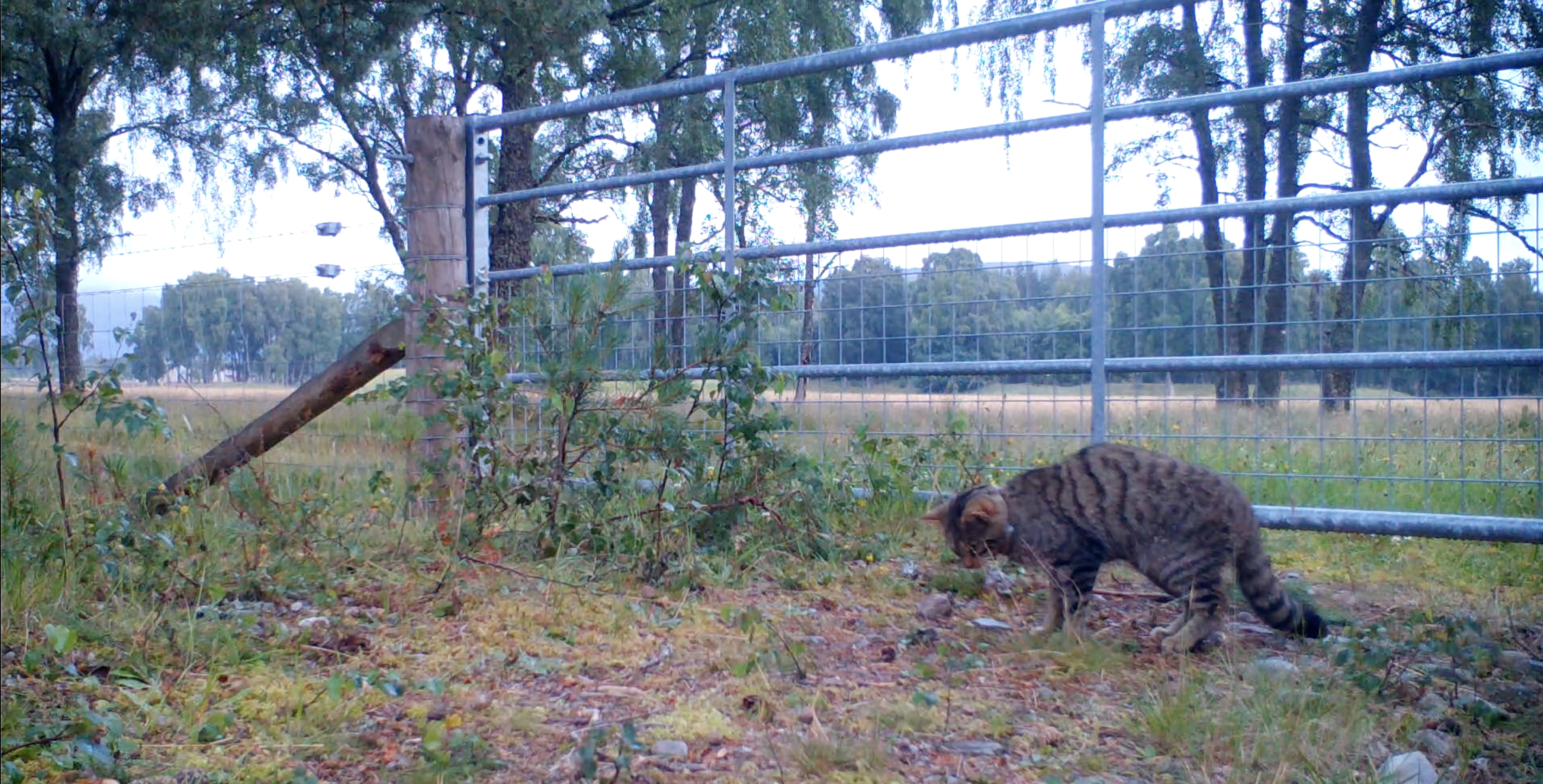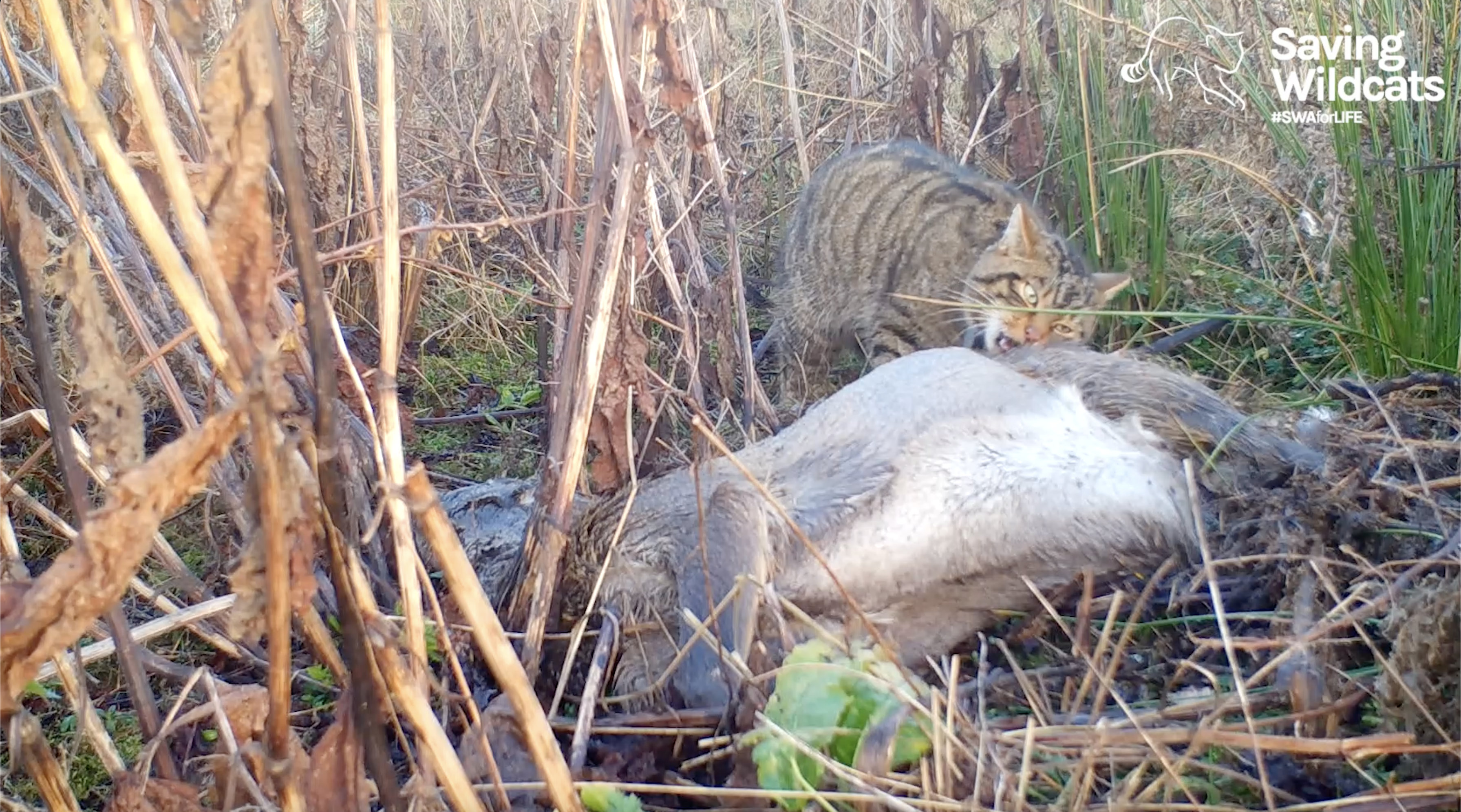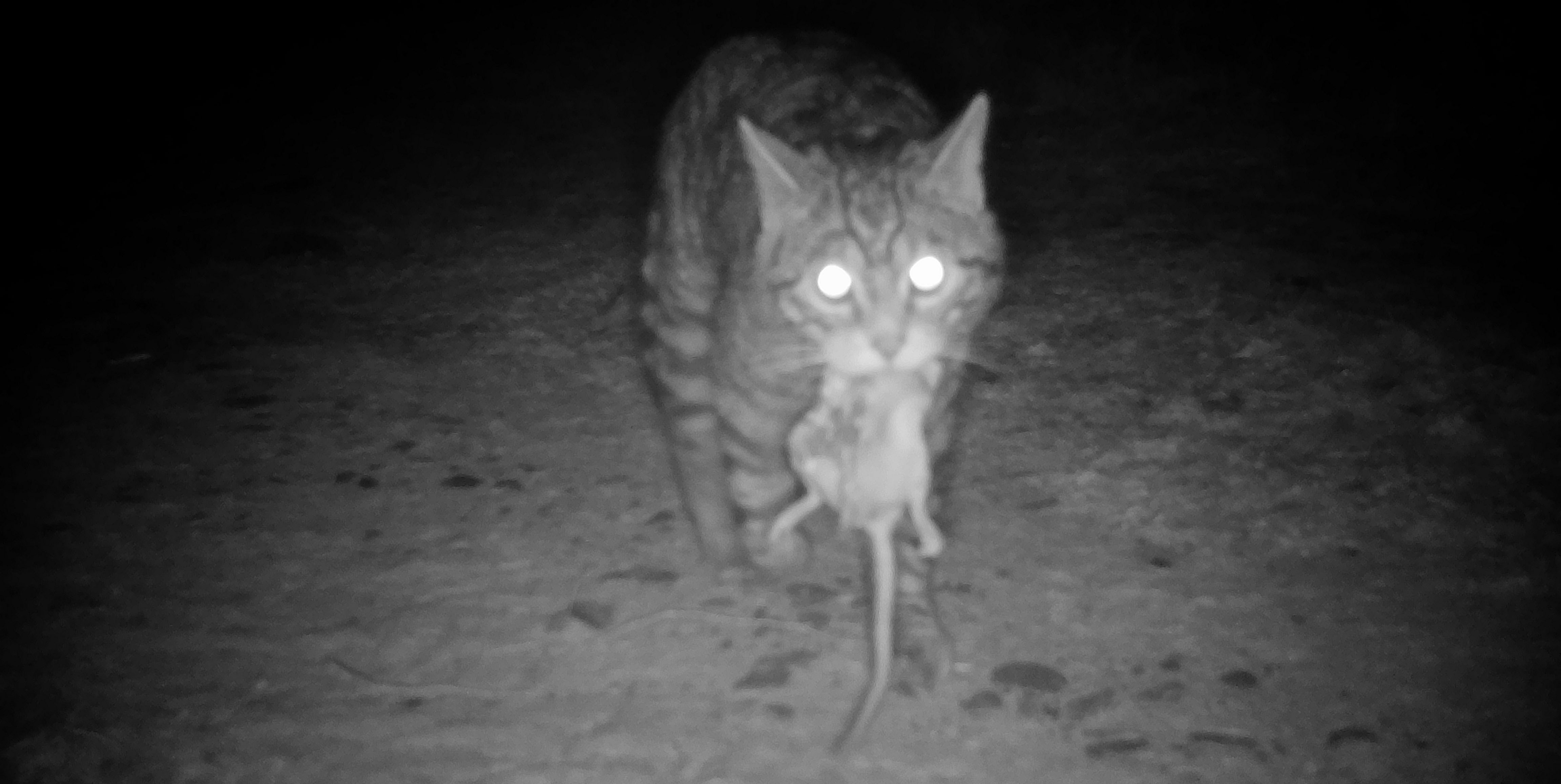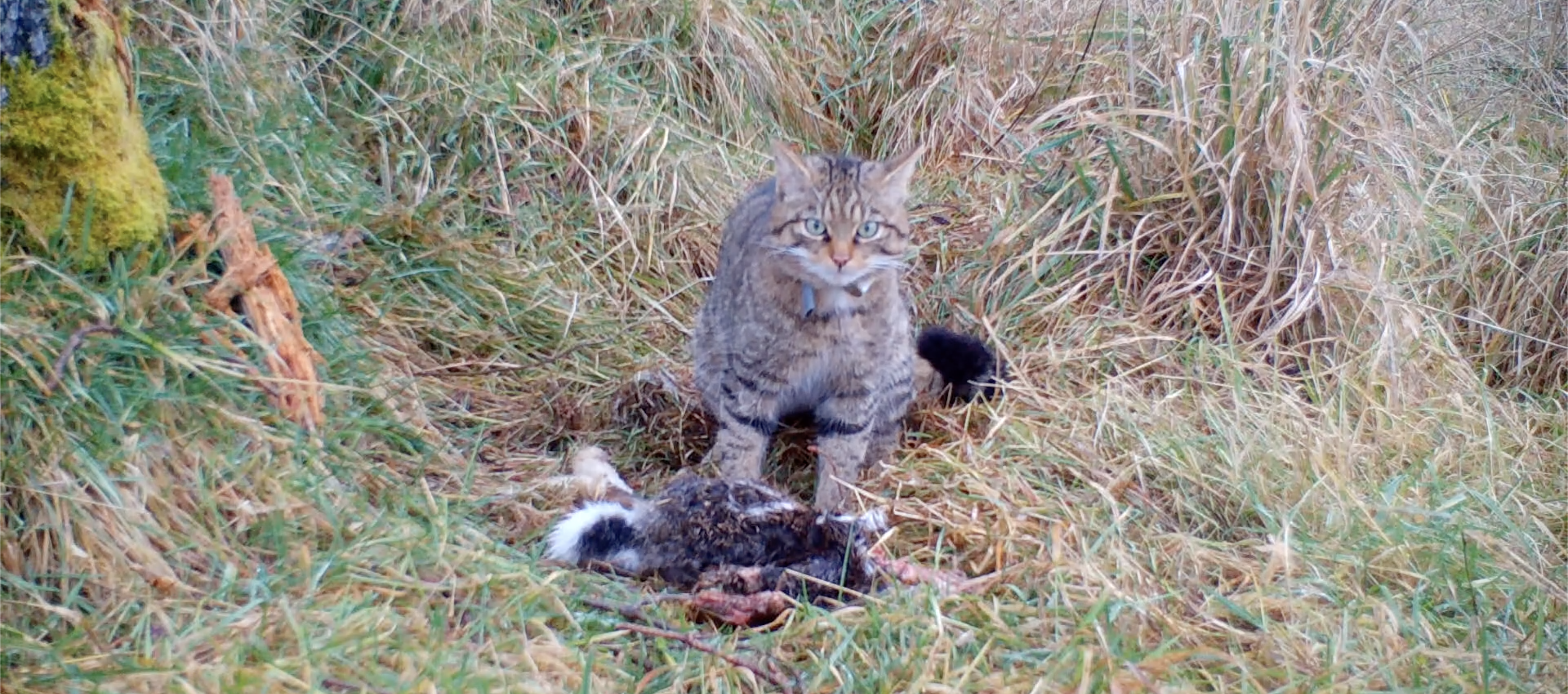What do wildcats eat?
The European wildcat, Felis silvestris silvestris, is the last surviving native cat species in mainland Britain. Like all felids, wildcats are obligate or ‘true’ carnivores because they depend on the consumption of meat for all their nutritional requirements, unlike omnivorous predators that are also able to digest plant matter. Diet is a comparatively well-studied aspect of wildcat ecology because composition can be elucidated from stomach contents and scat samples. Across their European range, wildcats primarily specialise on rodents (particularly mice and vole species) but will preferentially feed on rabbits, Oryctolagus cuniculus, when they are present, such as in Scotland (Corbett, 1979) and their native Mediterranean (Malo et al., 2004). A smaller part of the wildcat diet is opportunistic, and may include birds, hares, fish, reptiles, and insects. In 2018, Szeles et al.published a review of wildcat diet studies, which goes into further detail.
Since 2023, Saving Wildcats has released 28 wildcats into the Cairngorms Connect landscape of the Cairngorms National Park. The post-release behaviour of the released wildcats has been closely monitored by the field team using GPS-radio collars, camera-traps, and scat surveys. As the team track the animals’ movements and monitor their welfare, they are also gathering crucial information to help improve our understanding of wildcat ecology, including hunting and feeding behaviour.

Camera-traps placed around the soft release enclosures identified some of the wildcats hunting and eating small mammals soon after their release, and subsequent scat analyses have supported the crucial role of field voles, Microtus agrestis, in the diet of wildcats in the Cairngorms Connect landscape. The GPS tracking data further supports the importance of field voles in the diet, as the wildcats preferentially use the ‘vole’ habitats of rough grassland, scrub, and clear-fell forestry, whilst their movement and activity patterns are consistent with hunting. As predicted, wildcats have also been observed predating rabbits, and the GPS-tracking data suggests the preferential use of areas with high rabbit densities, mainly outside Cairngorms Connect on the western side of the river Spey.
In addition to hunting behaviour, the released wildcats have been observed feeding on carrion (deceased animals that were killed by some other means), which is termed ‘scavenging’. This was first observed by Saving Wildcats in early winter 2023, when the team went to investigate an anomaly with the daily GPS tracking data. A female wildcat, “Aizel”, had stopped moving for an unusually long time, and with the heavy snow and cold weather settling in, there were concerns for her welfare. A careful search of the location revealed a roe deer, Capreolus capreolus, carcass that had been ‘cached’ (partially buried under vegetation or snow). Subsequent monitoring of the carcass using a camera-trap revealed Aizel, as well as several of the released male wildcats, all returning to feed on the carcass, with Aizel resting close by under the shelter of some dense gorse bushes.

Scavenging behaviour has not been widely studied or reported in European wildcats, in part because they are rare and elusive animals that are difficult to observe in the wild. However, two recent studies have documented scavenging and caching of deer carcasses in northern Spain (Ruiz-Villar et al., 2020), as well as in Slovenia and northern Italy (Krofel et al., 2021). In both cases, this was associated with winter weather conditions including snowfall.
The released wildcats have since been recorded scavenging and caching carcasses of other larger prey species, including brown hares and greylag geese. The field team has the unique ability to find and record scavenging and/or predation events on larger prey animals, because the GPS tracking data highlights the location of carcasses through the clustering of GPS points. The wildcats’ behaviour can then be monitored at the carcasses using camera-traps. Using this approach, Saving Wildcats has recorded two instances of wildcats feeding on the remains of capercaillie carcasses: one female wildcat was captured feeding on the carcass of a sub-adult male, and a second female wildcat was filmed feeding on the carcass of an adult male. A third location with a large cluster of capercaillie feathers was identified close to the second female, but no carcass was found. These instances were recorded in the second year of releases in 2024, with none recorded after the release of 19 wildcats in 2023. Unfortunately, the carcasses were not in suitable condition for post-mortems to be carried out and, in the absence of direct behavioural observations of interactions between the species, it is not possible to know whether these instances were the result of predation or scavenging.
From an ecological perspective, wildcats and capercaillie usually occupy different habitats, with little interaction between the species. A flagship species of the pinewoods, capercaillie live in coniferous forests. Wildcats prefer a mosaic of broadleaf woodland, grassland and scrub habitats, rich in voles and rabbits. The capercaillie carcasses were found by the team in coniferous woodland blocks, in areas used by the two female wildcats in the months immediately after their release. Both wildcats left those areas shortly after the carcass feeding was recorded, and they have not returned, preferring the more open habitat around the river Spey. When they were released, the two female wildcats weighed 3.4 and 4.3 kg, which is similar to the weight of a young or small female domestic cat. An adult capercaillie, weighing up to 5kg, is likely to present a serious threat to a young and inexperienced wildcat, and predation of a healthy adult male seems unlikely. There are no published accounts of capercaillie predation by wildcats from across the European range, and a comprehensive diet study lists only one occurrence of capercaillie from the east Carpathians in 1953, from stomach contents identified and reported by hunters (Szeles et al. 2018).
Monitoring the interactions of the released wildcats with other species, particularly those of conservation concern, provides data that must be interpreted objectively because these are sensitive and important issues. Saving Wildcats continues to share information, with project partners and other conservation organisations, to gradually replace ‘unknowns’ with an evidence base.

In early summer 2024, one of the project’s survey cameras on RSPB Insh Marshes captured an image of a wildcat with what appeared to be a juvenile curlew in its mouth. This female wildcat has a home range of around 10 km2 encompassing a large area of grassland, mixed woodland and scrub between the river Spey and the coniferous woodland of Inshriach Forest. That vast area includes part of Insh Marshes National Nature Reserve (NNR). As with the capercaillie, it is not possible to tell from one ‘detection event’ if this was scavenging or predation, and if it was predation, was it an opportunistic occurrence, or a recurrent pattern of behaviour? Direct behavioural observations of predator-prey interactions are the only way to know for sure, and predation events of chicks are hardly ever captured on camera. RSPB Insh Marshes does have some incidental records of nest predation by other predators, but no cats to date.
There are many other predator species in the system, as there should be: predation is a natural process and is key to a healthy and balanced ecosystem. Native predators, including wildcats, often have a stabilising influence on the food chain below them, preventing common species from becoming overabundant and out-competing rarer species. Like all predators, wildcats will eat what is most abundant and easiest to catch, including ‘artificial’ prey resources provided by humans. In late summer, vast numbers of pheasants are released by many of the game-shooting estates surrounding the release site, and some of the released wildcats appear to be capitalising on this abundant resource. These estates also support some of the best habitat for wildcats, with rough grassland, scrub and mixed woodland in the lower ground, and often good rabbit populations. Saving Wildcats appreciates the ongoing positive conversations with land managers to consider how best to mitigate the associated interactions between wildcats and pheasants. Similarly, several of the released wildcats are known to have predated domestic chickens and ducks from the backyards of rural residents. The team is working closely with those affected and have produced guidance to assist domestic poultry keepers, including recommendations for predator-proofing enclosures. Sometimes wildcats predating human-mediated food resources can be beneficial for both parties, such as hunting rodents around farms, but more often it brings them into direct conflict with humans.

Saving Wildcats will continue to monitor the released wildcats and their offspring, in as much detail as possible, particularly with regards to diet and hunting behaviour. Upcoming research includes using DNA methods to examine wildcat scat content in detail. The future of wildcats in Scotland is fundamentally tied to what they eat. A healthy and sustainable population of wildcats requires a healthy and sustainable food source. Diverse natural prey populations (mice, voles and rabbits) could help ensure wildcats thrive in our landscapes once again, away from human settlements, thus mitigating the risks from humans and domestic cats.
If you have any questions about wildcats and their diet, please get in touch with the team directly at wildcats@rzss.org.uk.
References
Corbett LK (1979) Feeding ecology and social organization of wildcats (Felis silvestris) and domestic cats (Felis catus) in Scotland. PhD thesis. University Aberdeen
Krofel M, Južnicˇ D, Allen ML. (2021). Scavenging and carcass caching behavior by European wildcat (Felis silvestris). Ecological Research, 36:556–561
Malo AF, Lozano J, Huertas DL, Virgós E (2004) A change of diet from rodents to rabbits (Oryctolagus cuniculus). Is the wildcat (Felis silvestris) a specialist predator? J Zool 263:401–407
Ruiz-Villar, H., López-Bao, J. V., & Palomares, F. (2020). A small cat saving food for later: Caching behavior in the European wildcat (Felis silvestris silvestris). European Journal of Wildlife Research, 66, 76.
Szeles, G. L., Purger, J. J., Molnar, T. & Lanszki, J. (2018). Comparative analysis of the diet of feral and house cats and wildcats in Europe. Mammal Research, 63, 43-53

